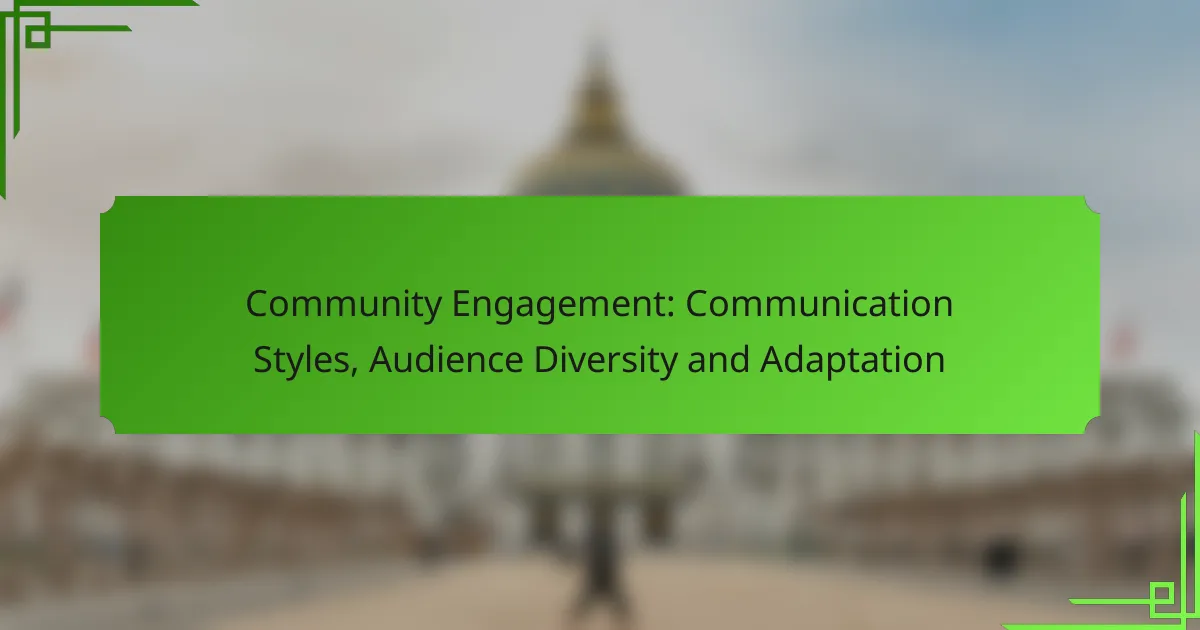Community engagement is essential for enhancing communication styles, as it promotes a two-way dialogue that encourages feedback and adaptation. By tailoring messaging to resonate with diverse audiences, organizations can foster more effective interactions and ensure that their communication is inclusive and engaging.
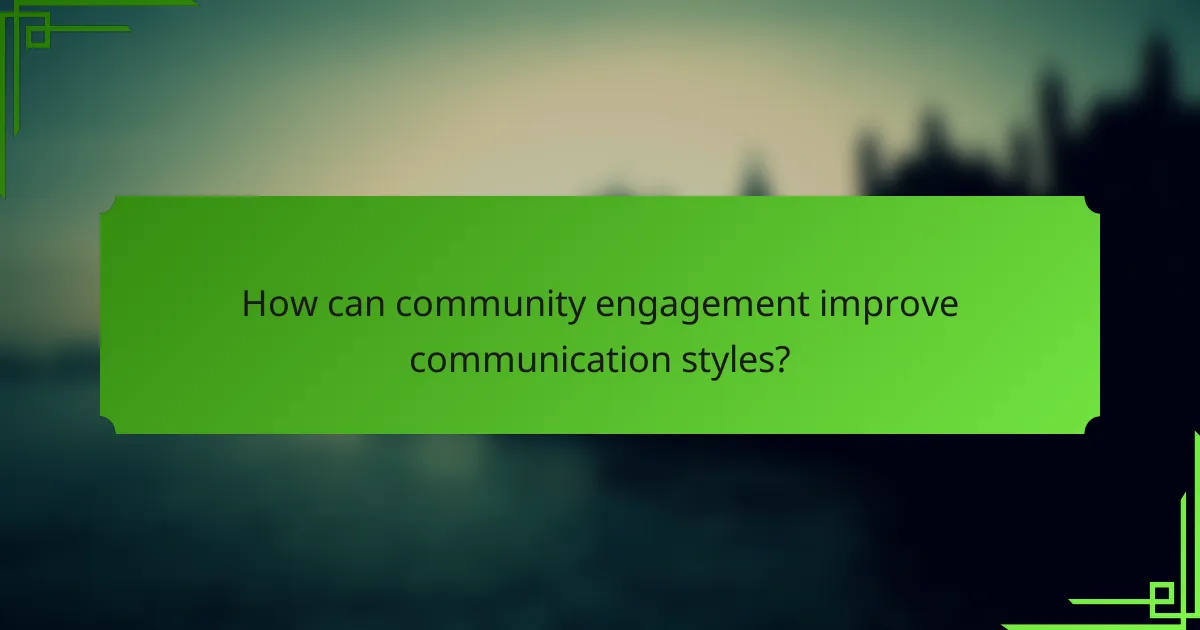
How can community engagement improve communication styles?
Community engagement enhances communication styles by fostering a two-way dialogue that encourages feedback and adaptation. This process allows organizations to tailor their messaging to better resonate with diverse audiences, ultimately leading to more effective interactions.
Enhanced clarity in messaging
Improving clarity in messaging is crucial for effective community engagement. By actively listening to community feedback, organizations can identify misunderstandings and adjust their communication strategies accordingly. This may involve simplifying language, using visuals, or providing additional context to ensure messages are easily understood.
For example, when communicating about local regulations, using straightforward language and relatable examples can help demystify complex topics. Aim for a reading level that matches your audience’s familiarity with the subject matter.
Increased audience participation
Engaging with the community can significantly boost audience participation. When individuals feel their voices are heard and valued, they are more likely to contribute to discussions and initiatives. Utilizing various platforms—such as social media, community forums, or surveys—can help reach a broader audience.
Consider offering incentives for participation, such as recognition or small rewards, to motivate community members to engage. Regularly updating the community on how their input has influenced decisions can further encourage ongoing participation.
Stronger relationships with stakeholders
Building stronger relationships with stakeholders is a key benefit of effective community engagement. By fostering open lines of communication, organizations can create trust and mutual respect with community members and partners. This relationship can lead to collaborative efforts that benefit both parties.
To strengthen these relationships, prioritize transparency and consistency in communication. Regularly share updates on projects and initiatives, and invite stakeholders to participate in decision-making processes. This approach not only enhances trust but also cultivates a sense of ownership among community members.
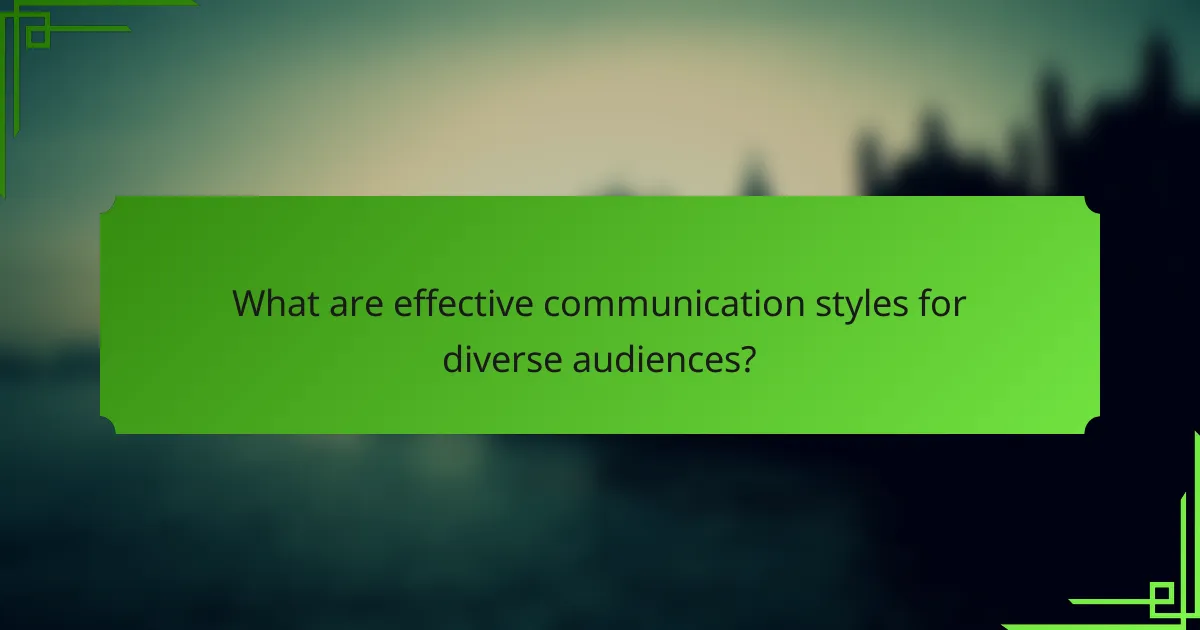
What are effective communication styles for diverse audiences?
Effective communication styles for diverse audiences involve adapting language and methods to meet the needs of various groups. This includes using inclusive language, visual aids, and active listening to ensure clarity and engagement.
Inclusive language use
Using inclusive language means choosing words that respect and acknowledge diversity among audiences. This can involve avoiding jargon, using gender-neutral terms, and being mindful of cultural sensitivities.
For example, instead of saying “mankind,” use “humankind” to encompass all people. Additionally, consider the preferences of your audience regarding pronouns and titles to foster a welcoming environment.
Visual communication techniques
Visual communication techniques enhance understanding by using images, charts, and infographics. These tools can break down complex information and cater to visual learners, making content more accessible.
When presenting data, consider using color-coded graphs or diagrams to illustrate key points. Ensure that visuals are clear and relevant to the audience’s context, avoiding overly intricate designs that may confuse rather than clarify.
Active listening strategies
Active listening strategies involve fully engaging with the speaker to understand their message. This includes nodding, maintaining eye contact, and summarizing what has been said to confirm comprehension.
Encourage questions and feedback to create a two-way dialogue. Avoid interrupting and give the speaker time to express their thoughts, which fosters trust and respect in communication.
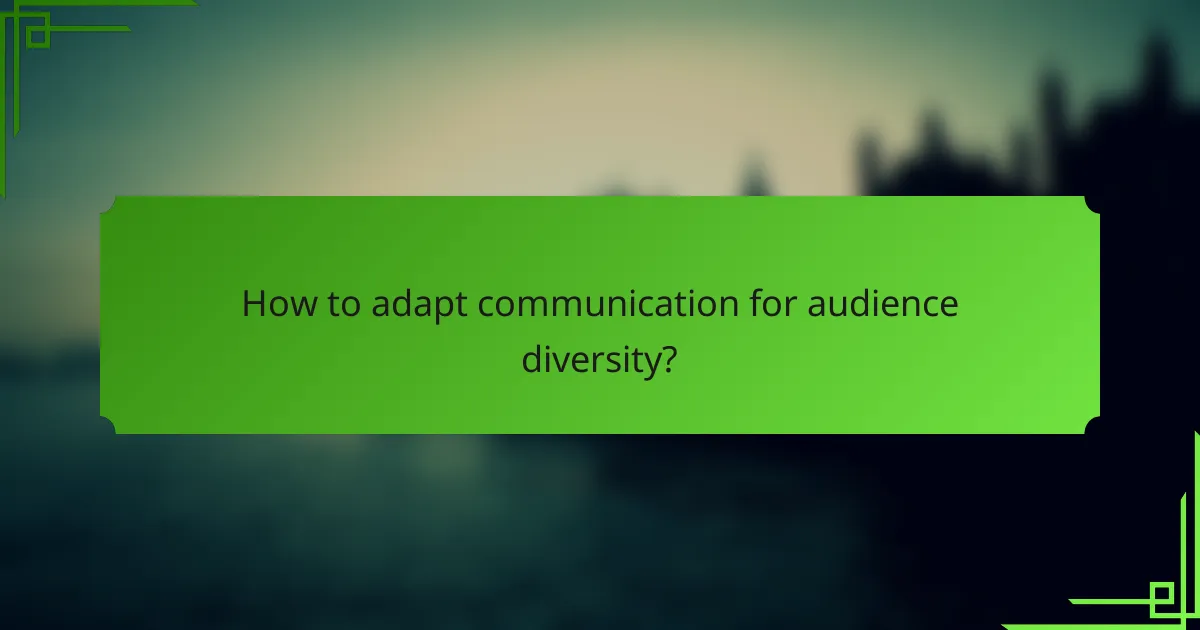
How to adapt communication for audience diversity?
Adapting communication for audience diversity involves recognizing and addressing the varied backgrounds, preferences, and needs of different groups. This ensures that messages resonate effectively and foster engagement across diverse populations.
Understanding cultural differences
Recognizing cultural differences is crucial for effective communication. Cultures vary in their values, communication styles, and social norms, which can influence how messages are received. For instance, some cultures may prefer direct communication, while others value indirect approaches.
To navigate these differences, research the cultural backgrounds of your audience. This can involve understanding language nuances, gestures, and even the significance of certain topics. For example, discussing personal achievements may be celebrated in some cultures but viewed as boastful in others.
Tailoring messages to audience needs
Tailoring messages involves customizing content to meet the specific needs and preferences of your audience. This can include using appropriate language, tone, and examples that resonate with the audience’s experiences. For instance, using local idioms or references can enhance relatability.
Consider segmenting your audience based on demographics, interests, or communication preferences. This allows for more targeted messaging. For example, a community health initiative might use different strategies for engaging teenagers compared to older adults, focusing on social media for the former and community meetings for the latter.
Utilizing feedback for improvement
Feedback is essential for refining communication strategies. Actively seek input from your audience through surveys, focus groups, or informal conversations. This helps identify areas for improvement and ensures that communication remains relevant and effective.
Implement a regular feedback loop to assess the impact of your messages. For instance, if a particular campaign is not resonating, gather insights on why that might be and adjust your approach accordingly. This iterative process fosters continuous improvement and strengthens community engagement.
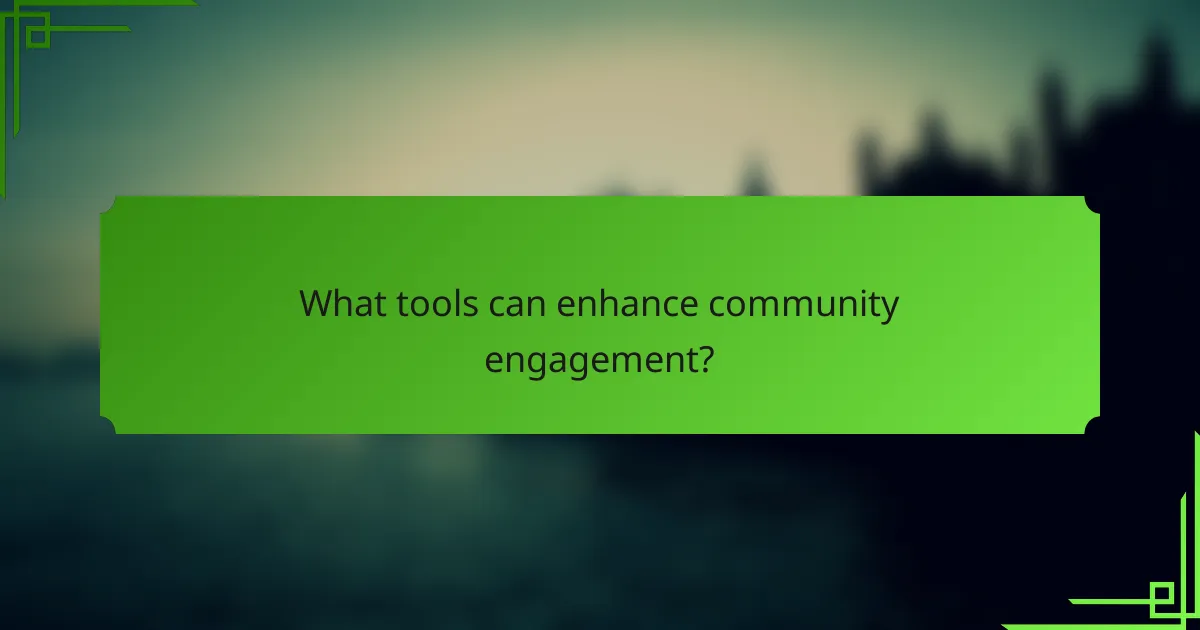
What tools can enhance community engagement?
Effective community engagement tools facilitate communication and foster connections among diverse audiences. Utilizing the right platforms can significantly improve interaction, feedback, and overall involvement in community initiatives.
Social media platforms
Social media platforms are essential for enhancing community engagement by providing spaces for real-time interaction. Popular platforms like Facebook, Twitter, and Instagram allow organizations to share updates, gather feedback, and create discussions among community members.
When using social media, consider your audience’s preferences. For example, younger demographics may prefer Instagram or TikTok, while older audiences might engage more on Facebook. Tailoring your content to fit each platform can increase engagement rates.
Community forums
Community forums serve as dedicated spaces for discussion and information sharing among members. Platforms like Reddit or specialized community boards enable users to post questions, share experiences, and provide support to one another.
To maximize effectiveness, ensure that forums are moderated to maintain a respectful and constructive environment. Encourage participation by highlighting popular topics and recognizing active members, which can foster a sense of belonging and commitment.
Survey and feedback tools
Survey and feedback tools are vital for gathering insights from community members. Tools like Google Forms, SurveyMonkey, or Typeform allow organizations to create customized surveys that can assess community needs, preferences, and satisfaction levels.
When designing surveys, keep them concise and focused to encourage completion. Aim for a mix of multiple-choice and open-ended questions to gather both quantitative and qualitative data. Regularly reviewing feedback can help adapt strategies and improve community engagement efforts.
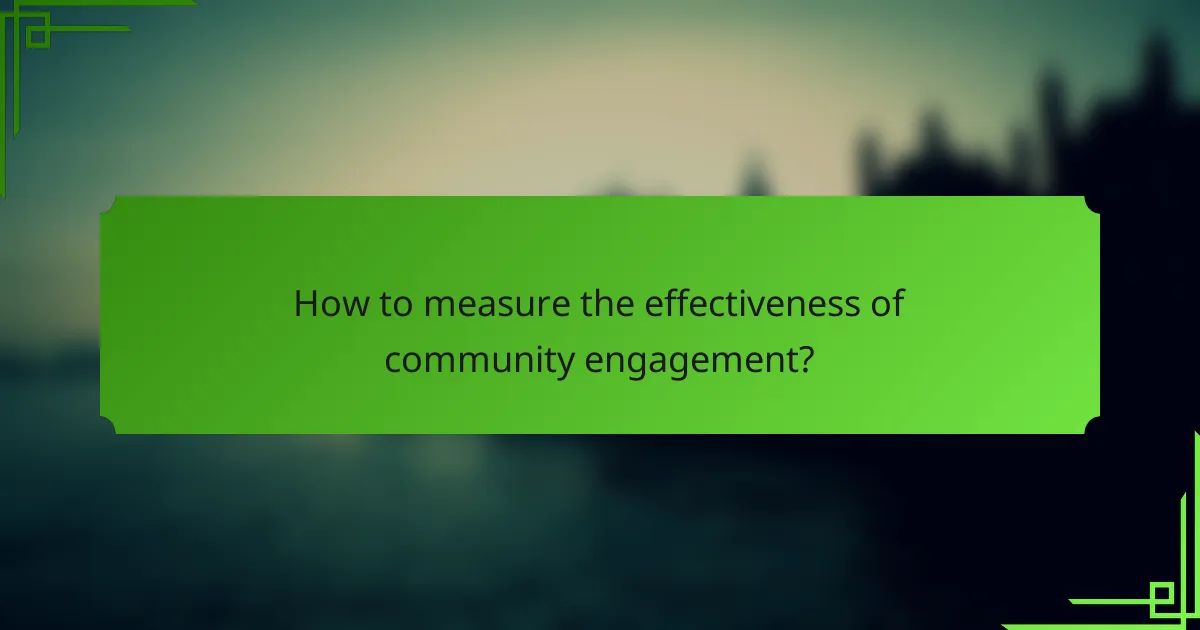
How to measure the effectiveness of community engagement?
Measuring the effectiveness of community engagement involves assessing how well communication strategies resonate with diverse audiences. Key indicators include participation rates, feedback quality, and the overall impact on community goals.
Engagement metrics analysis
Engagement metrics analysis focuses on quantifying participation levels and interactions within the community. Common metrics include attendance at events, social media interactions, and survey responses. Tracking these metrics over time helps identify trends and areas for improvement.
Consider using tools like Google Analytics for online engagement or attendance tracking systems for in-person events. Aim for a mix of quantitative data and qualitative insights to get a comprehensive view of engagement effectiveness.
Feedback collection methods
Feedback collection methods are essential for understanding community perceptions and experiences. Surveys, interviews, and focus groups are effective ways to gather input from diverse audience segments. Ensure questions are clear and relevant to encourage honest and constructive feedback.
Utilize online platforms for surveys to reach a broader audience, and consider offering incentives for participation to increase response rates. Regularly analyze feedback to adapt engagement strategies accordingly.
Impact assessment frameworks
Impact assessment frameworks help evaluate the outcomes of community engagement initiatives. These frameworks typically involve setting clear objectives, measuring outputs, and assessing the resulting changes in the community. Popular models include Logic Models and Theory of Change.
When implementing an impact assessment, define specific metrics related to your goals, such as community satisfaction or behavioral changes. Regularly review and adjust your frameworks to reflect evolving community needs and engagement strategies.
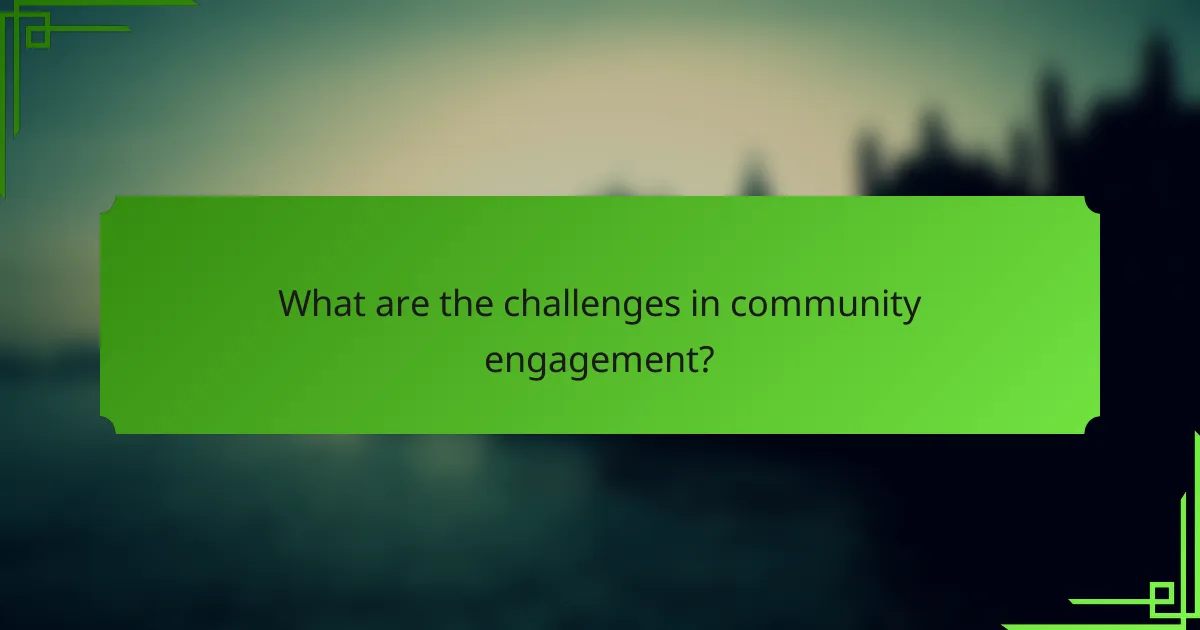
What are the challenges in community engagement?
Community engagement faces several challenges that can hinder effective communication and participation. Key issues include resource allocation, audience diversity, and the need for adaptable communication styles to meet varying community needs.
Resource allocation issues
Resource allocation issues arise when there are insufficient funds, personnel, or materials to support community engagement efforts. This can lead to underfunded programs that fail to reach their intended audience or achieve their goals.
To address these challenges, organizations should conduct a thorough assessment of available resources and prioritize initiatives based on community needs. For example, allocating a budget of a few thousand USD for outreach activities can significantly enhance engagement if spent wisely on targeted communication strategies.
Common pitfalls include spreading resources too thin across multiple projects or failing to secure ongoing funding. Establishing partnerships with local businesses or government entities can help mitigate these issues and provide additional support.
